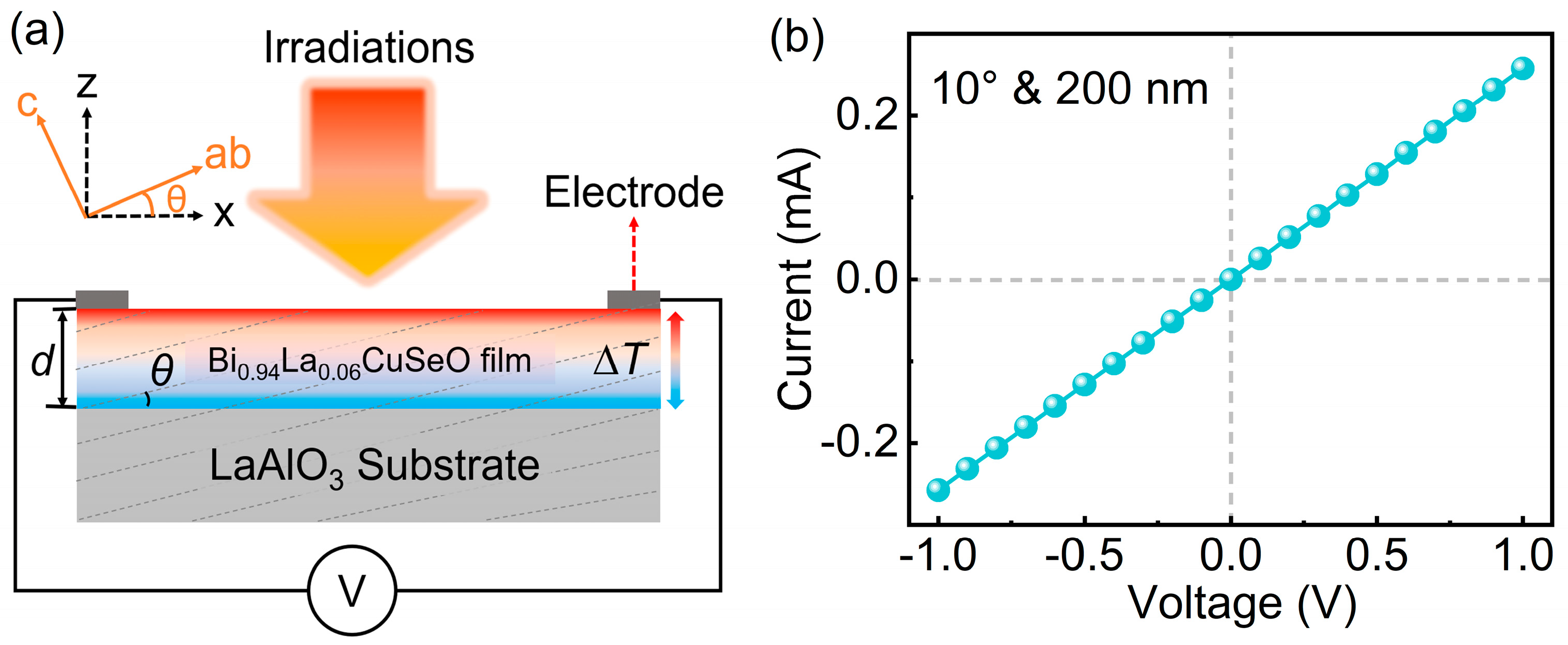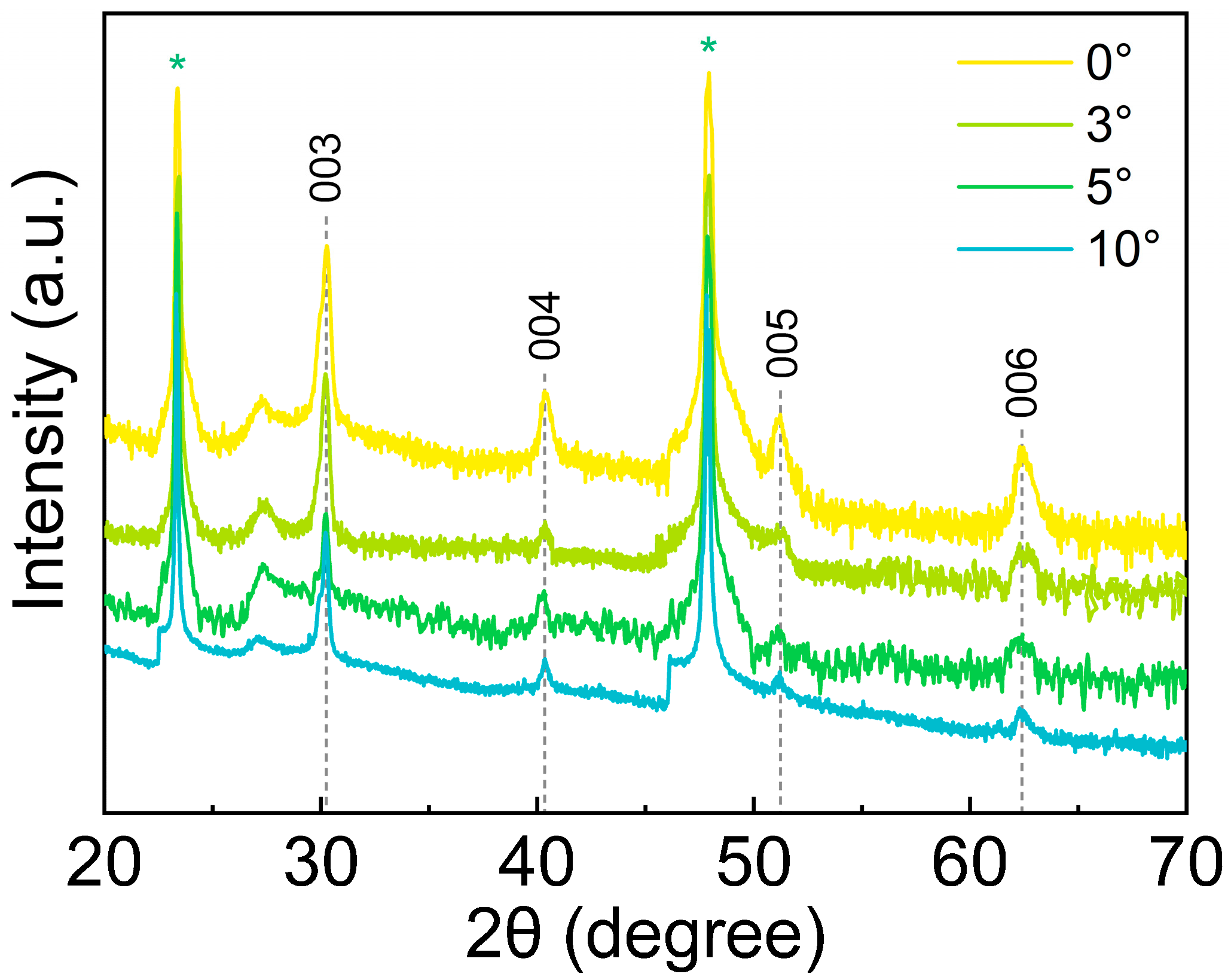Angle-Engineered Bi0.94La0.06CuSeO Thin Films for High-Performance Transverse Thermoelectric Devices
Abstract
1. Introduction
2. Materials and Methods
3. Results
3.1. Thin Film Crystal Structure Characterization
3.2. Pulsed Photodetection
3.3. CW Photodetection
3.4. Heat Flux Detection
4. Conclusions
Author Contributions
Funding
Institutional Review Board Statement
Informed Consent Statement
Data Availability Statement
Conflicts of Interest
References
- Lengfellner, H.; Zeuner, S.; Prettl, W.; Renk, K.F. Thermoelectric effect in normal-state YBa2Cu3O7−δ films. EuroPhys. Lett. 1994, 25, 375–378. [Google Scholar] [CrossRef]
- Chen, G.; Dresselhaus, M.S.; Dresselhaus, G. Recent developments in thermoelectric materials. Int. Mater. Rev. 2003, 48, 45–66. [Google Scholar] [CrossRef]
- Chen, M.J.; Chen, X.Y.; Wang, Q.Y.; Ning, X.K.; Li, Z.L.; Yan, G.Y.; San, X.Y.; Wang, S.F. Ultra-broadband light detection based on the light-induced transverse thermoelectric effect of epitaxial PbSe thin films with inclined structure. Appl. Phys. Lett. 2022, 120, 173505. [Google Scholar] [CrossRef]
- Chen, X.; Tao, B.W.; Zhao, R.P.; Zhong, Y.; Yang, K.; Li, Z.Z.; Xie, T.; Zhang, T.; Xia, Y.D. Inclined ITO thin film with thermoelectric anisotropy: A promising sensitivity material for ultraviolet pulsed photodetector based on light-induced transverse voltage effect. Opt. Mater. 2024, 147, 114657. [Google Scholar] [CrossRef]
- Zhang, P.X.; Sticher, U.; Leibold, B.; Habermeier, H. Thickness dependence of the thermoelectric voltages in YBaCuO7−δ thin films on tilted substrate of SrTiO3. Phys. C 1997, 282, 2551–2552. [Google Scholar] [CrossRef]
- Yu, L.; Wang, Y.; Zhang, P.X.; Habermeier, H.U. Ultrafast transverse thermoelectric response in c-axis inclined epitaxial La0.5Sr0.5CoO3 thin films. Phys. Status Solidi RRL 2013, 7, 180–183. [Google Scholar] [CrossRef]
- Takahashi, K.; Kanno, T.; Sakai, A.; Adachi, H.; Yamada, Y. Gigantic transverse voltage induced via off-diagonal thermoelectric effect in CaxCoO2 thin films. Appl. Phys. Lett. 2010, 97, 021906. [Google Scholar] [CrossRef]
- Wang, Y.; Yu, L.; Jiang, B.; Zhang, P.X. Transverse thermoelectric response in tilted orientation La1−xSrxCoO3 (0.05 ≤ x ≤ 0.4) thin films. J. Appl. Phys. 2011, 110, 123111. [Google Scholar] [CrossRef]
- Song, S.; Yu, L.; Hu, J.; Liu, A.; Zhong, Y. Laser-induced transverse voltage effect and thermopower anisotropy of c-axis inclined Ca3Co4O9 thin film. Appl. Phys. A 2017, 123, 595. [Google Scholar] [CrossRef]
- Cheng, W.P.; He, Y.D.; Wei, R.H. Ultraviolet laser-driven ultra-high transverse voltage in Bi-2201 thin films. Appl. Phys. Lett. 2024, 124, 071105. [Google Scholar] [CrossRef]
- Chang, C.L.; Kleinhammes, A.; Moulton, W.G.; Testardi, L.R. Symmetry-forbidden laser-induced voltages inYBa2Cu3O7. Phys. Rev. B Condens. Matter. 1990, 41, 11564. [Google Scholar] [CrossRef] [PubMed]
- Zhao, K.; He, M.; Liu, G.Z.; Lu, H.B. Photo-induced voltage characteristics of La0.9Sr0.1MnO3 films epitaxially grown on vicinal SrTiO3(001) substrates. J. Phys. D Appl. Phys. 2007, 40, 5703. [Google Scholar] [CrossRef]
- Chen, X.; Tao, B.W.; Zhao, R.P.; Yang, K.; Xia, Y.D.; Li, Z.Z.; Xie, T.; Zhong, Y.; Zhang, T. High-frequency response heat flux sensor based on the transverse thermoelectric effect of inclined La1-xCaxMnO3 films. Appl. Phys. Lett. 2022, 121, 204102. [Google Scholar] [CrossRef]
- Sun, Y.J.; Wu, H.R.; Yu, L.; Sun, H.; Zhang, P.X.; Zhang, X.W.; Dai, B.; Wang, Y. Utilizing the Transverse Thermoelectric Effect of Thin Films for Pulse Laser Detection. Sensors 2022, 22, 4867. [Google Scholar] [CrossRef]
- Chen, H.; Wang, Y.; Yi, Z.; Dai, B.; Tang, B.; Xu, X.; Yi, Y. Ultra-high-sensitivity and -stability thin-film heat flux sensor based on transverse thermoelectric effect. Coatings 2023, 13, 1610. [Google Scholar] [CrossRef]
- Chen, X.; Tao, B.W.; Zhao, R.P.; Yang, K.; Li, Z.Z.; Xie, T.; Zhong, Y.; Zhang, T.; Xia, Y.D. The atomic layer thermopile heat flux sensor based on the inclined epitaxial YBa2Cu3O7-δ films. Mater. Lett. 2023, 330, 133336. [Google Scholar] [CrossRef]
- Yan, G.Y.; Wang, L.; Qiao, S.; Wu, X.; Wang, S.F.; Fu, G.S. Light-induced transverse voltage effect in c-axis inclined BiCuSeO single crystalline thin films. Opt. Mater. Express 2016, 6, 558–565. [Google Scholar] [CrossRef]
- Wu, J.; Yan, G.Y.; Chen, M.J.; Xue, Y.L.; Gao, L.; Wang, J.L.; Wang, S.F. Enhanced light-induced transverse thermoelectric effect in c-axis inclined Ba-doped BiCuSeO thin films. Appl. Surf. Sci. 2021, 570, 121254. [Google Scholar] [CrossRef]
- Wang, L.; Yan, G.Y.; Dong, G.; Qiao, S.; Fu, G.S.; Wang, S.F. Enhanced light-induced transverse thermoelectric effect in c-axis inclined BiCuSeO thin films via Pb doping. Opt. Mater. Express 2016, 6, 2537–2544. [Google Scholar] [CrossRef]
- Chen, M.J.; Wang, X.C.; Ning, X.K.; Chen, Z.H.; Zhen, Y.Y.; Yue, C.M.; Yan, G.Y.; Fang, L.D.; Wang, S.F. Self-powered high-performance photo and thermal detectors based on the transverse thermoelectric effect of the inclined La-doped BiCuSeO films. Appl. Surf. Sci. 2024, 655, 159579. [Google Scholar] [CrossRef]
- Chen, X.; Tao, B.W.; Zhao, R.P.; Yang, K.; Li, Z.Z.; Xie, T.; Zhong, Y.; Zhang, T.; Xia, Y.D. Efficient preparation of the inclined La1-xCaxMnO3 films with excellent light-induced transverse thermoelectric performance based on MOCVD process. Vacuum 2023, 208, 111695. [Google Scholar] [CrossRef]
- Yan, G.Y.; Bai, Z.L.; Wang, S.F.; Sun, L.Q.; Wang, J.L.; Fu, G.S. Dependence of oxygen content on transverse thermoelectric effect in tilted Bi2Sr2Co2Oy thin films. Appl. Opt. 2014, 53, 4211–4215. [Google Scholar] [CrossRef] [PubMed]




Disclaimer/Publisher’s Note: The statements, opinions and data contained in all publications are solely those of the individual author(s) and contributor(s) and not of MDPI and/or the editor(s). MDPI and/or the editor(s) disclaim responsibility for any injury to people or property resulting from any ideas, methods, instructions or products referred to in the content. |
© 2025 by the authors. Licensee MDPI, Basel, Switzerland. This article is an open access article distributed under the terms and conditions of the Creative Commons Attribution (CC BY) license (https://creativecommons.org/licenses/by/4.0/).
Share and Cite
Chen, M.; Yue, C.; Qin, T.; Liu, H.; Yan, G.; Wang, S. Angle-Engineered Bi0.94La0.06CuSeO Thin Films for High-Performance Transverse Thermoelectric Devices. Sensors 2025, 25, 2791. https://doi.org/10.3390/s25092791
Chen M, Yue C, Qin T, Liu H, Yan G, Wang S. Angle-Engineered Bi0.94La0.06CuSeO Thin Films for High-Performance Transverse Thermoelectric Devices. Sensors. 2025; 25(9):2791. https://doi.org/10.3390/s25092791
Chicago/Turabian StyleChen, Mingjing, Chenming Yue, Tianchang Qin, Haixu Liu, Guoying Yan, and Shufang Wang. 2025. "Angle-Engineered Bi0.94La0.06CuSeO Thin Films for High-Performance Transverse Thermoelectric Devices" Sensors 25, no. 9: 2791. https://doi.org/10.3390/s25092791
APA StyleChen, M., Yue, C., Qin, T., Liu, H., Yan, G., & Wang, S. (2025). Angle-Engineered Bi0.94La0.06CuSeO Thin Films for High-Performance Transverse Thermoelectric Devices. Sensors, 25(9), 2791. https://doi.org/10.3390/s25092791





